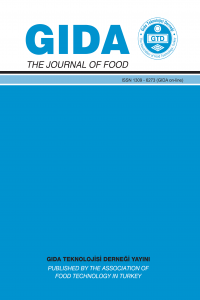ZEYTİNYAĞI ENDÜSTRİSİ KATI ATIĞININ DEĞERLENDİRİLMESİ: AÇIK RENKLİ HEMİSELÜLOZLAR İÇİN ALKALİ ÖZÜTLEME KOŞULLARININ İSTATİSTİKSEL OPTİMİZASYONU
Abstract
Zeytinyağı üretim sürecinin yan-ürünü olan zeytin katı atığı (ZKA), çok
düşük ekonomik değere sahip bir lignoselülozik materyaldir. ZKA’nın hemiselüloz
fraksiyonu, birçok endüstriyel uygulama için hammadde olarak kullanım
potansiyeline sahiptir. Bu çalışmanın temel amacı, ZKA’dan mümkün olan en
yüksek ham hemiselüloz özütleme verimine ulaşmak için bir alkali özütleme
tekniğinin istatistiksel olarak geliştirilmesi ve bunun yanında siyah
hemiselülozların renginin açılmasıdır. Optimizasyon için Box-Behnken Tasarımı
temelli tepki yüzey metodolojisi kullanılmıştır. Optimum hemiselüloz özütleme
koşulları %19,3 (a/h) alkali (KOH) konsantrasyonu,
25,3 saat özütleme süresi, %1 (a/h) MgSO4 konsantrasyonu, %6,4 (h/h)
H2O2 konsantrasyonu ve 60°C sıcaklık olarak tespit edilmiştir. Bu
koşullardaki en yüksek deneysel hemiselüloz verimi %35,6±0,5 olup, teorik değer
olan %31,2 ile uyumludur. Sonuç olarak, özütleme verimi %21,7’den %35,6’ya
(a/a) çıkarılmıştır. Optimum koşullarda özütlenen hemiselülozların renk
değerleri (L*,a*,b*) sırasıyla 31,69±0,28, -2,90±0,04 ve 5,49±0,04 olarak bulunmuştur. Çalışmanın sonuçları, gıda paketleme uygulamaları
için biyobozunur plastikler ve ksilooligosakkaritler gibi endüstriyel öneme
sahip katma değerli ürünlere dönüştürülme potansiyeline sahip açık renkli ZKA
hemiselülozlarının izole edilmesi için yol göstermektedir.
Keywords
Zeytin katı atığı ön işlem hemiselüloz özütleme optimizasyon tepki yüzey metodolojisi atık değerlendirme
References
- Romero-Garcia JM, Nino L, Martinez-Patino C, Alvarez C, Castro E, Negro MJ. 2014. Biorefinery based on olive biomass. State of the art and future trends. Bioresour Technol 159:421-432.
- Nzihou A. 2010. Toward the valorization of waste and biomass. Waste Biomass Valor 1:3-7.
- Fava F, Totaro G, Diels L, Reis M, Duarte J, Carioca OB, Poggi-Varaldo HM, Ferreira BS. 2015. Biowaste biorefinery in Europe: Opportunities and research & development needs. New Biotechnol 32:100-108.
- Kalogiannis KG, Stefanidis S, Marianou A, Michailof C, Kalogianni A, Lappas A. 2015. Lignocellulosic biomass fractionation as a pretreatment step for production of fuels and green chemicals. Waste Biomass Valor 6:781-790.
- Peng P, She D. 2014. Isolation, structural characterization, and potential applications of hemicelluloses from bamboo: A review. Carbohydr Polym 112:701-720.
- Saxena A, Ragauskas AJ. 2009. Water transmission barrier properties of biodegradable films based on cellulosic whiskers and xylan. Carbohydr Polym 78:357-360.
- Bahcegul E, Toraman HE, Erdemir D, Akinalan B, Ozkan N, Bakir U. 2014. An unconventional approach for improving the integrity and mechanical properties of xylan type hemicellulose based films. RSC Adv 4:34117-34126.
- Zhang Y, Pitkanen L, Douglade J, Tenkanen M, Remond C, Joly C. 2011. Wheat bran arabinoxylans: Chemical structure and film properties of three isolated fractions. Carbohydr Polym 86:852-859.
- Singh RD, Banerjee J, Arora A. 2015. Prebiotic potential of oligosaccharides: A focus on xylan derived oligosaccharides. Bioact Carbohydr Diet Fibre 5:19-30.
- Tatar F, Tunç MT, Dervişoğlu M, Çekmecelioğlu D, Kahyaoğlu T. 2014. Evaluation of hemicellulose as a coating material with gum arabic for food microencapsulation. Food Res Int 57:168-175.
VALORIZATION OF OLIVE-OIL INDUSTRY SOLID WASTE: STATISTICAL OPTIMIZATION OF ALKALINE EXTRACTION CONDITIONS FOR LIGHT-COLOURED HEMICELLULOSES
Abstract
Olive solid
waste (OSW), the by-product of olive oil production process, is a lignocellulosic material with very
low economic value. The hemicellulose fraction of OSW has a potential to be
used as a raw material for several industrial applications. The main objective of the present work was to statistically develop an
alkaline hemicellulose extraction procedure to achieve the highest possible crude
hemicellulose extraction yield from OSW with concurrent efforts to
lighten the colour of black hemicelluloses. Box-Behnken Design based response surface
methodology was employed for optimization. The optimum hemicellulose extraction conditions were found as 19.3% (w/v)
alkaline (KOH) concentration,
mm
concentration, 6.4% (v/v) H2O2 concentration and 60°C temperature. The maximum
experimental hemicelluloses yield at this condition was 35.6±0.5% which is in
agreement with the predicted yield value of 31.2%. As a result, the extraction yield has been increased from 21.7% to
35.6% (w/w). The colour values (L*,a*,b*) of hemicelluloses extracted at
optimum conditions were predicted as 31.69±0.28, -2.90±0.04 and 5.49±0.04, sequentially. The findings
of this study demonstrated the route for isolation of light-coloured OSW hemicelluloses that have potential
for conversion into industrially important value-added products such as
biodegradable plastics for food packaging applications and xylooligosaccharides.
Keywords
Olive solid waste pretreatment hemicellulose extraction optimization response surface methodology waste valorization
References
- Romero-Garcia JM, Nino L, Martinez-Patino C, Alvarez C, Castro E, Negro MJ. 2014. Biorefinery based on olive biomass. State of the art and future trends. Bioresour Technol 159:421-432.
- Nzihou A. 2010. Toward the valorization of waste and biomass. Waste Biomass Valor 1:3-7.
- Fava F, Totaro G, Diels L, Reis M, Duarte J, Carioca OB, Poggi-Varaldo HM, Ferreira BS. 2015. Biowaste biorefinery in Europe: Opportunities and research & development needs. New Biotechnol 32:100-108.
- Kalogiannis KG, Stefanidis S, Marianou A, Michailof C, Kalogianni A, Lappas A. 2015. Lignocellulosic biomass fractionation as a pretreatment step for production of fuels and green chemicals. Waste Biomass Valor 6:781-790.
- Peng P, She D. 2014. Isolation, structural characterization, and potential applications of hemicelluloses from bamboo: A review. Carbohydr Polym 112:701-720.
- Saxena A, Ragauskas AJ. 2009. Water transmission barrier properties of biodegradable films based on cellulosic whiskers and xylan. Carbohydr Polym 78:357-360.
- Bahcegul E, Toraman HE, Erdemir D, Akinalan B, Ozkan N, Bakir U. 2014. An unconventional approach for improving the integrity and mechanical properties of xylan type hemicellulose based films. RSC Adv 4:34117-34126.
- Zhang Y, Pitkanen L, Douglade J, Tenkanen M, Remond C, Joly C. 2011. Wheat bran arabinoxylans: Chemical structure and film properties of three isolated fractions. Carbohydr Polym 86:852-859.
- Singh RD, Banerjee J, Arora A. 2015. Prebiotic potential of oligosaccharides: A focus on xylan derived oligosaccharides. Bioact Carbohydr Diet Fibre 5:19-30.
- Tatar F, Tunç MT, Dervişoğlu M, Çekmecelioğlu D, Kahyaoğlu T. 2014. Evaluation of hemicellulose as a coating material with gum arabic for food microencapsulation. Food Res Int 57:168-175.
Details
| Journal Section | Articles |
|---|---|
| Authors | |
| Publication Date | March 22, 2017 |
| Published in Issue | Year 2017 Volume: 42 Issue: 3 |



